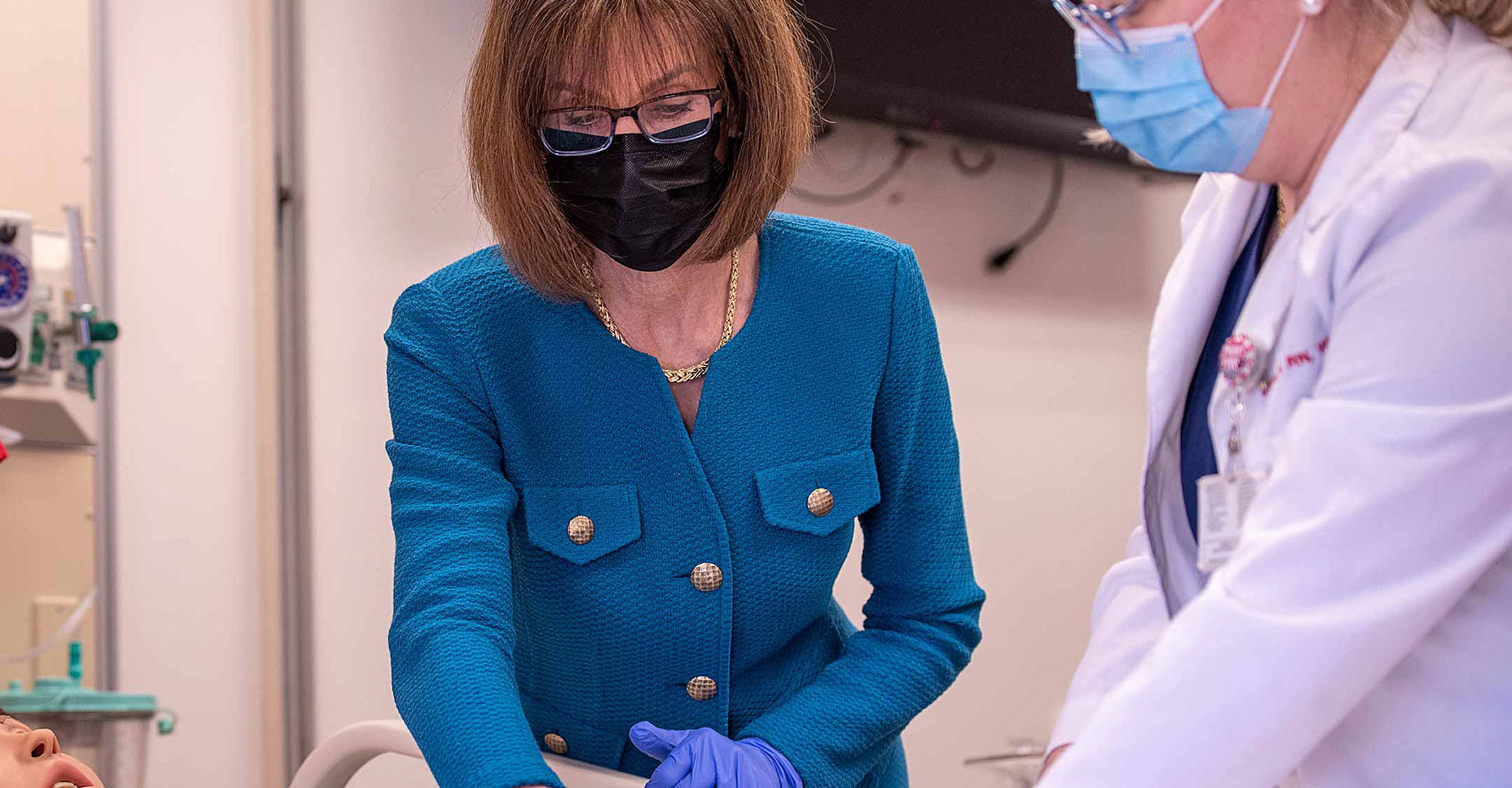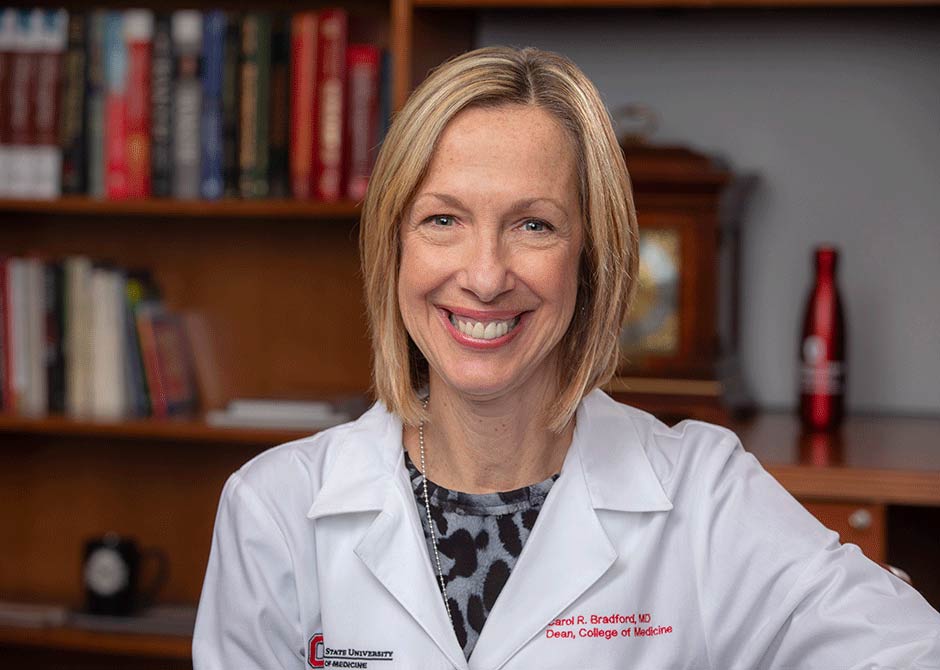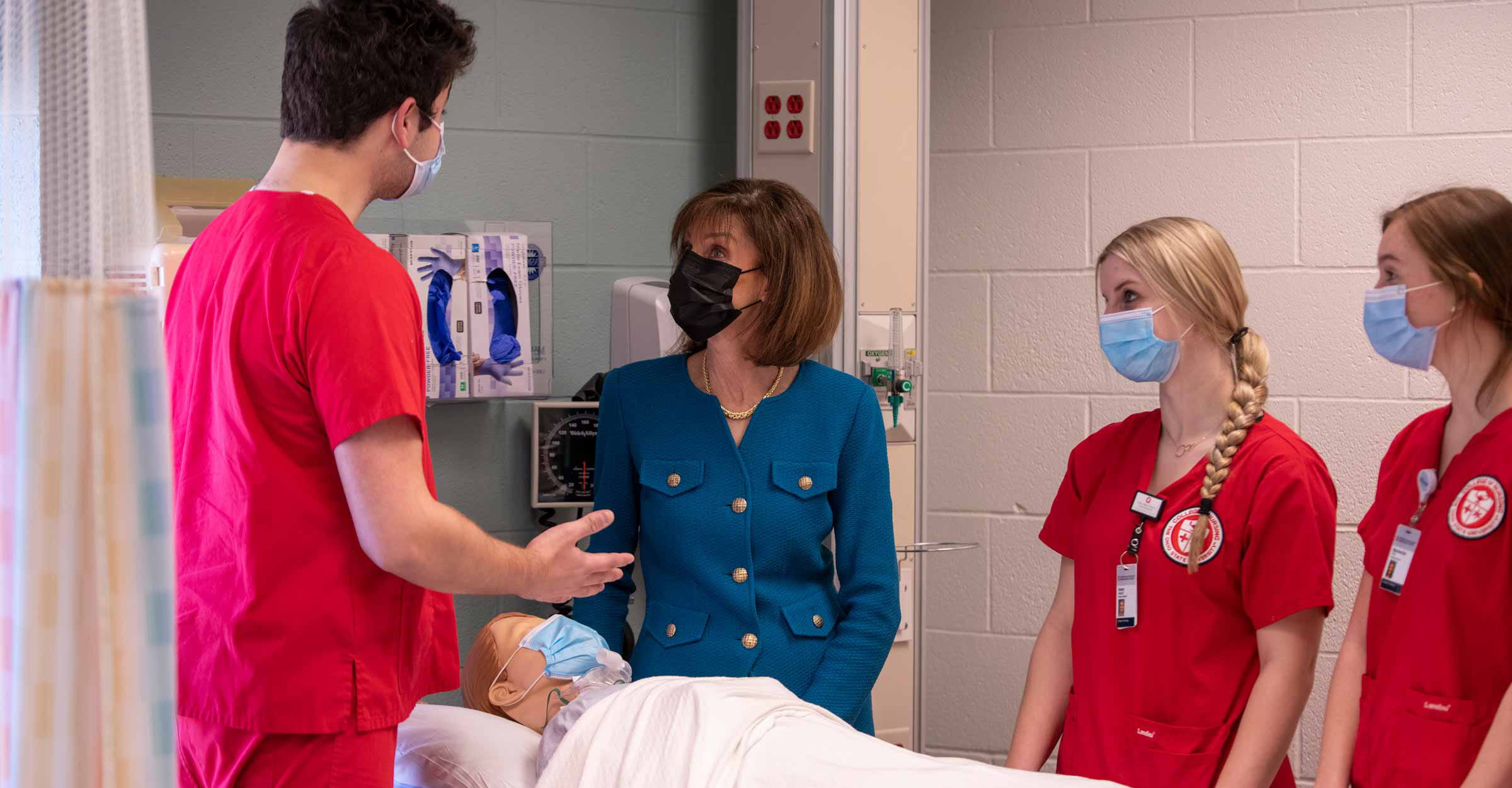Reimagining how we teach health care
Andrea Pfeifle, EdD, PT, FNAP, is connecting interprofessional teams, patient care and education at Ohio State.
Andrea Pfeifle’s life purpose began to take shape as a teenager babysitting an 11-year-old boy who used a wheelchair due to severe spastic cerebral palsy.
He lived with his parents in Lexington, Kentucky, near her hometown of Versailles. She saw the immense challenges they faced—feeding, skin care, positioning, bowel and bladder functioning, range of motion exercises, bed transfers and other basic practices. She longed to improve things for this child she had come to know and love while volunteering at the local children’s hospital—and for his parents—but didn’t yet have the skills to do so. Neither did the well-intentioned and well-trained doctors and hospital caretakers.
She realizes now the gap was the lack of a treatment plan that considered every aspect of his life, including his living conditions and any physical, emotional and socio-economic barriers that might interfere with progression toward better health.
That profoundly impactful relationship led Andrea to a career in health care, where she could ensure that families and patients are cared for in a more humane, holistic way. Dr. Pfeifle is doing just that as Ohio State’s first associate vice chancellor for Interprofessional Practice and Education (IPE). The new role advances the university’s plan to establish a culture of interprofessional collaboration among the seven health science colleges, across the university and into the community. She’s tasked with bridging health care education to health care delivery.
At its core, IPE challenges the way we teach and provide health care. It demands that we prepare to practice medicine differently than we historically have, in individual silos and without considering the “total” patient.
Interprofessional education brings students from two or more professions together during their training to learn about, from and with one another to improve health outcomes and to cultivate collaboration and provide patient-centered care. But doing this involves specific knowledge, skills and experiences that are best learned with other professions or disciplines and outside the lecture hall.

With a physical therapy degree from the University of Kentucky in hand, Dr. Pfeifle started her career caring for patients in the early 1980s. She soon learned it was necessary to reach out to other professions, disciplines, community members and caregivers—from speech therapists to occupational therapists to social workers—to help her patients progress to optimum health.
“As a physical therapist, I cannot do my job well without working with the whole health care team. If I give a client an elaborate program to address pain or function, but I don’t simultaneously understand and take into account their medications, nutritional status, hazards in the home, social determinants and other relevant factors—if I don’t understand what they want to get done or what’s in the way of getting it done and work with them and other caregivers on the team to address these needs—then no matter how good the physical therapy treatment program is, it’s not going to make a difference,” she says.
This collaborative approach has worked well for her, and it caught the eye of leaders at the University of Kentucky, who recruited her to teach this health care model to their students. From 1998 to 2014, she was director of Education in the Department of Family and Community Medicine, chair of the Interprofessional Education Working Group and inaugural director of the Center for Interprofessional Education, Research and Practice. While there, she grew her own education, earning a Doctor of Instruction and Administration in Education.
She loves helping both students and universities successfully implement interprofessional collaborative practice. Dr. Pfeifle connects emotionally with the care model. She loves helping both students and universities successfully implement interprofessional collaborative practice. Dr. Pfeifle connects emotionally with the care model.
“For me, it’s been a lifelong love affair! IPE connects care with people where they spend most of their time, in the community.” Dr. Andrea Pfeifle, Associate Vice Chancellor for Interprofessional Practice and Education
“It’s about finding solutions to real challenges, such as those imposed by social and other determinants of health, and advancing the social and humanistic missions shared across the health professions. That really speaks to me,” she says.
From the University of Kentucky, Dr. Pfeifle was recruited to Indiana University, where she spent six years serving as executive director of its Interprofessional Practice and Education Center and associate dean of Interprofessional Health Education and Practice. She worked across the university and in the community to develop a statewide curriculum to prepare a future health care workforce for interprofessional collaboration and team practice.
Dr. Pfeifle also led a critical statewide response to Indiana’s crippling opioid addiction crisis by establishing new models of integrated interprofessional practice and education and sharing best practices with people around the country who were also committed to ending the epidemic.

Bigger aspirations were calling
When she caught word that Ohio State was creating a position that would incorporate interprofessional practice and education across the university and in the medical center, she was more than intrigued. This was the challenge she’d been looking for, the place where she could make real change on a grand scale. As impressed with Ohio State as Ohio State was with her, Dr. Pfeifle became a Buckeye in July 2020.
“Given the number of highly ranked health science education programs collocated on one campus and the variety of other professional programs and disciplines that are also here, as well as its size, scope, mission and history—combined with its partnership with the Wexner Medical Center and its deep roots in the community—make Ohio State the perfect place for interprofessional practice and education to thrive. Here, academicians and practitioners are working together every day to advance innovative models of collaborative care. It is very much a holistic effort. We’re able to integrate education into practice and at the same time fill gaps in care and provide needed services in the community. Here, our learners are an integral part of the work we are doing.
“More importantly, the talent and commitment of the people here is palpable. Ohio State has the opportunity to re-imagine best-in-class interprofessional practice and education while designing new integrated care platforms that truly do improve the health and well-being of Ohio and the nation. We can do that because of who we are, where we are, what we are and how we are.”
Excitement of Dr. Pfeifle’s hire echoed among both academics and learners across campuses.
"Dr. Pfeifle’s expertise in creating synergy among health science colleges will launch Ohio State to the next level, not just in education, but also in research and care delivery," said Carol R. Bradford, MD, MS, FACS, Dean, The Ohio State University College of Medicine, Vice President for Health Sciences, The Ohio State University Wexner Medical Center.

“When organizations harness the power of interprofessional education, teams of health science experts make life-altering biomedical discoveries that change the way we deliver care.” Carol R. Bradford, MD, MS, FACS
Our plan to implement interprofessional practice and education at Ohio State
Dr. Pfeifle is one of the trailblazers in IPE, which garners her invitations to serve on industry-shaping boards and committees, including the National Center for Interprofessional Practice and Education, the American Interprofessional Health Collaborative (of which she is a founding member), the Canadian Interprofessional Health Collaborative, the National Academies of Practice and InterprofessionalResearch.Global.
Recently, the Interprofessional Practice and Education Collaborative tapped her to become part of an expert panel of 16 leaders tasked with developing a tool that standardizes the assessment of institutional progress toward IPE implementation.
Beginning with the fall 2021 semester, each student entering Ohio State’s College of Medicine will become part of an interprofessional team with other students from the colleges of Arts & Sciences, Dentistry, Optometry, Nursing, Pharmacy, Public Health, Social Work and Veterinary Medicine. These learners will work together throughout their time at Ohio State to learn about what Ohio State has determined are our community’s greatest areas of need: mental health and addiction, income/poverty and maternal and infant health.
One of the student experiences is a new Interprofessional Community Scholars Program, which brings students together with people living in the Near East Side of Columbus to improve digital literacy and to assess and address gaps in their care.
The ultimate goal of interprofessional practice and education is to achieve the “Quintuple Aim,” a term used in the health care realm that ties specific actions for change to improved health outcomes. The five measurables are improved patient experience, improved population health, reduced costs, improved care team well-being and improved health equity.

What does success look like?
Strong partnerships with and in the community that ultimately improve health and well-being, and students driven by the desire to make a difference.
”With the right infrastructure in place to support our students learning with, about and from each other to advance health and well-being, we can make a bigger, better impact on our community and address today's critical health problems. Ohio State has some great education and practice programs to build on and is committed to its vision as the model 21st century public, land grant, research, urban, community-engaged institution. We're well-poised to transform education and care together.”
“The essence of IPE is bringing education together with care—care for real people with real challenges to health and well-being—to change the way we provide care right now and in the future.” Dr. Andrea Pfeifle, Associate Vice Chancellor for Interprofessional Practice and Education
Interprofessional Practice and Education at Ohio State
Under construction and scheduled to open in 2023, the Ohio State Interdisciplinary Health Sciences Center is located in the heart of the newly planned health sciences campus, laid out to facilitate blending professionals from the university’s seven health science colleges. The center will house two large classrooms that can accommodate 150 or more trainees, and provide opportunities for collaborations that solve real health care problems for real patients in the community.
Ohio State’s Interprofessional Community Scholars Program comprises health care professional learners, including students, Family and Community Medicine residents and nurses, working together with volunteer mentors and community health care providers to treat patients on Columbus’ Near East Side. The team assesses each patient’s areas of need, sets health care goals, identifies obstacles and barriers to success and develops a plan of action. Students continue working in their teams throughout the four years of the program.

Q&A: Interprofessional Practice and Education Frequently Asked Questions
Find out what Ohio State College of Medicine is doing to improve health care through interprofessional practice and education in this conversation with Dr. Andrea Pfeifle.
Read the Q&A



